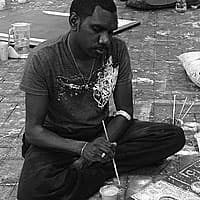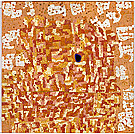Daniel WALBIDI

I paint to educate people about my culture and our history, and where we come from, so to give people understanding. I also paint so I can learn about my culture from the old people. It is important for me to paint so I can keep my culture strong and living so it can be carried on into the future.
Painting is not just limited to what you see. Daniel Walbidi 2009[1]
Daniel Walbidi, a young Mangala/Yulparitja man from Bidyadanga (La Grange Mission) on the north-western Australian coast is one of a handful of prominent desert painters who have emerged from this region in the last ten years. Although the Yulparitja’s traditional lands lie in the far west of the Great Sandy Desert, the establishment of the La Grange Mission in 1956, 250 kilometres south-west from Broome, coincided with a widespread drought, and many Aboriginal people from the desert regions, including Walbidi’s parents, moved there.
Walbidi has lived his entire life at Bidyadanga, and grew up hearing the Dreaming stories associated with the vast desert landscape, of the precious fresh waterholes filled with the ‘living water’ created by the ancestors. These waterholes are the resting places of these powerful spirits. Walbidi built graphic images in his mind and later, as an artist, he began to depict these epic Dreaming narratives. As a young boy at school, he developed a key interest in Aboriginal art, studying some of the great Aboriginal artists—Albert Namatjira, Clifford Possum Tjapaltjarri, Emily Kam Kngwarray and Rover Thomas.
Keen to ensure the stories of the old people at Bidyadanga would be documented prior to their passing, Walbidi took it upon himself at the age of 16 to gather support to develop a potential community of artists. He saw art as an effective tool that would allow the cultural leaders to communicate these stories in vivid detail. He approached the Short St Gallery in Broome and requested its assistance in establishing an environment that would allow art to be created and marketed to a wider audience. Some 11 years later, works by established artists from this region, such as Weaver Jack, Donald Moko, Alma Webou Kalaju, Jan Billycan and Daniel Walbidi, are held in state, national and private collections within Australia and overseas.
In 2007, Walbidi accompanied a group of senior Yulparitja artists on a return to their traditional lands around Winpa and Kirriwirri (Walbidi’s father’s Country). Among the artists in the group were Walbidi’s father Nabiru (Harry Bullen) and Wokka and Mukki Taylor, senior cultural leaders and Elders. It was these men of significant cultural standing who introduced Walbidi to his Country and told him the stories of their ancestors. For the very first time, Walbidi and the senior painters sat on their Country and painted the Dreaming stories. The Elders had reacquainted themselves with their ancestors and the vast landscape of their youth. This was such an emotional visit that many wanted to paint what they were feeling.[2]
The experience, including a helicopter flight over his father’s Country, was such a revelation to Walbidi that he began to paint in a very different way. He introduced more blocks of colour into his compositions, aligned in the familiar manner but now also layered. The Country is layered with degrees of information—public or general, private or restricted—and the artist reflects this in the way he paints. What we see on the surface is but one layer, and Walbidi was introduced on his journey to the multiple layers that lay below the surface. He paints these layers of information but does not reveal them; he alludes to and acknowledges but does not disclose. His paintings also became quite structured and detailed, colours compressed to such an extent that the energy bursts off the canvas. Walbidi also started to incorporate silver and gold paint; the sandhills glow gold and the water sparkles silver.
Walbidi’s early paintings are panoramas of his Country seen from afar. Viewed from a distance, the painted forms appear large and merge one into another. Walbidi’s recent experiences revealed to him the wondrous details of his Country, which he incorporates into his paintings today.
Franchesca Cubillo
[1] Daniel Walbidi, ‘Daniel Walbidi’, interview by Emily Rohr, Australian Aboriginal Art, no , 2009, p 4.
[2] This remarkable journey was recorded in the documentary Desert heart, Australian Broadcast Corporation, Sydney, 2008. Narrated by Daniel Walbidi.




